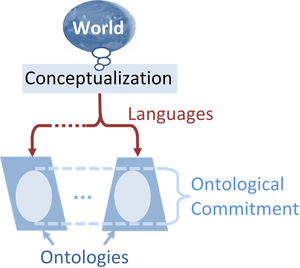Ontological commitment
The term ontological commitment is used as a general term in both philosophy and in information systems to refer to the essential elements of an ontology. Quine proposed that given some theory its ontological commitment could be found by what might be called a translation via techniques of symbolic logic and a search through this translation for statements involving there exists at least one ‘such-and-such’.[3] Such statements are called quantifier expressions and the formulation ‘there exists’ in symbolic logic is represented by the 'turned E' or ∃.[4] A list of the ‘such-and-such’ can then be examined to determine subsets that can serve as minimal sets in terms of which the others can be defined, and any such minimal set is an ontological commitment of the theory. This approach appears to involve only a list of ‘such-and-such’, but of course finding a minimal set of ‘such-and-such’ also involves at least some of the relations specified to hold between them.
The need to discuss and compare ontologies leads to the idea of a 'conceptualization', a higher level abstraction for which a given ontology is a very particular realization, possibly only one of many realizations of the 'conceptualization'. Each ontology based upon the same overarching conceptualization is then thought of as engendering a particular 'ontological commitment' that maps the conceptualization into specific examples of ‘such-and-such’ and their relationships. The 'conceptualization' allows discussion of its various possible implementations. The question then arises as to how to describe the 'conceptualization' in terms that can encompass multiple 'ontological commitments'. This issue has been called the 'Tower of Babel' problem, that is, how can persons used to one ontology talk with others using a different ontology?[5][2] This problem is easily understood, but a general resolution is not at hand. It can be a 'bottom-up' or a 'top-down' approach, or something in between.[6]
An example of the problems encountered in comparing ontologies is found in translation between human languages. Ostensibly, as all humans live in the same world and have the same physical senses with which to see the world, one might expect to correlate human activity with language and thereby make rules for translation. However, that view is utopian because humans act upon cultural interpretation of their surroundings, and relating two cultures is an entirely different matter than understanding what term in both represents a 'rabbit'.[7][8] Some suggest that humans think in 'mentalese', but so far we don't have access to this level of conceptualization.[9]
However, in more artificial situations, such as information systems, the idea of a 'conceptualization' and 'ontological commitment' to various ontologies that realize the 'conceptualization' is possible.[1][10] A trivial example of moving conception into a language leading to a variety of ontologies is the expression of a process in pseudocode (a strictly structured form of ordinary language) leading to implementation in several different formal computer languages like Lisp or Fortran. The pseudocode makes it easier to understand the instructions and compare implementations, but the formal languages make possible the compilation of the ideas as computer instructions.
Another example is mathematics, where a very general formulation (the analog of a conceptualization) is illustrated with 'applications' that are more specialized examples. For instance, aspects of a function space can be illustrated using a vector space or a topological space that introduce interpretations of the 'elements' of the conceptualization and additional relationships between them but preserve the connections required in the function space.
References
- ↑ 1.0 1.1 Nicola Guarino (1998). “Formal Ontology in Information Systems”, Nicola Guarino, ed: Formal Ontology in Information Systems (Proceedings of FOIS '98, Trento, Italy). IOS Press, pp. 3 ff. ISBN 978-90-5199-399-8.
- ↑ 2.0 2.1 Frank van Harmelen. Ontology mapping: a way out of the medical tower of babel.
- ↑ For a discussion and a critique see Peter van Inwagen (2008). “Chapter 6: Quine's 1946 lecture on nominalism”, Dean Zimmerman, ed: Oxford Studies in Metaphysics: Volume 4. Oxford University Press, pp. 125 ff. ISBN 0191562319.
- ↑ Dag Westerståhl (Apr 19, 2011). Edward N. Zalta, ed.):Generalized Quantifiers. The Stanford Encyclopedia of Philosophy (Summer 2011 Edition).
- ↑ Barry Smith (2003). “Chapter 11: Ontology”, Blackwell Guide to the Philosophy of Computing and Information. Blackwell, pp. 155-166. ISBN 0631229183.
- ↑ In information science, one approach to finding a conceptualization (or avoiding it and using an automated comparison) is called 'ontology alignment' or 'ontolgy matching'. See for example, Jérôme. Euzenat, Pavel Shvaiko (2007). Ontology Matching. Springer. ISBN 3540496122.
- ↑ Willard v. O. Quine (2013). Word and Object, New. MIT Press. ISBN 9780262518314. Quine raised the issue of translation and 'holophrastic' indeterminacy of translation in a series of books and papers.
- ↑ Crispin Wright (1999). “Chapter 16: The indeterminacy of translation”, Bob Hale, Crispin Wright, eds: A Companion to the Philosophy of Language. Wiley-Blackwell. ISBN 0631213260. "Quine's contention that translation is indeterminate has been among the most widely discussed and controversial theses in modern analytical philosophy."
- ↑ Murat Aydede (September 17, 2010). Edward N. Zalta, ed:The language of thought hypothesis. The Stanford Encyclopedia of Philosophy (Fall 2010 Edition).
- ↑ Nicola Guarino, Massimiliano Carrara, Pierdaniele Giaretta (1994). "Formalizing ontological commitments". AAAI 94: pp. 560-567.
